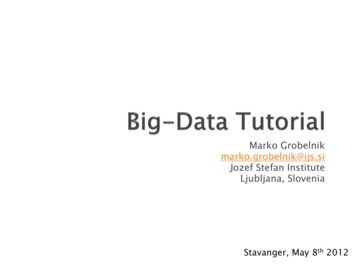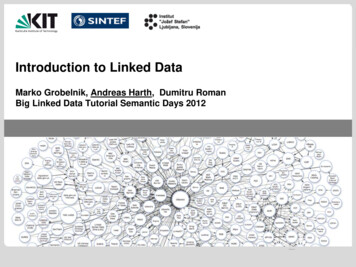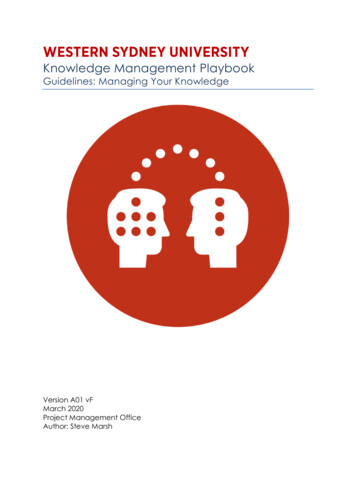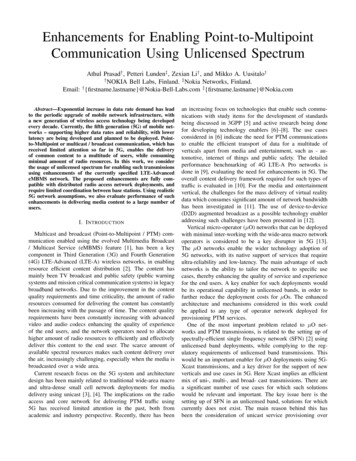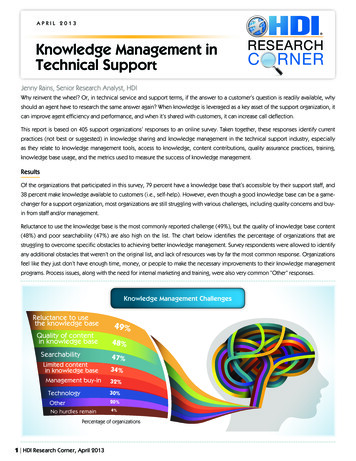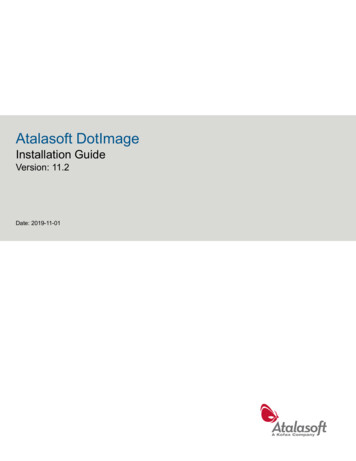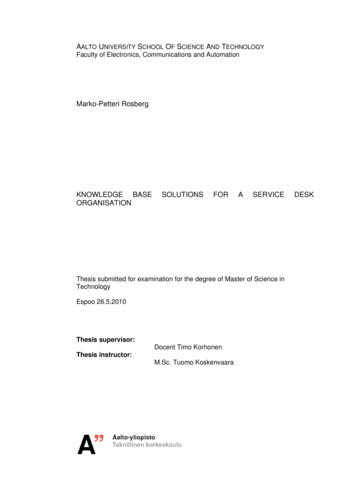
Transcription
AALTO UNIVERSITY SCHOOL OF SCIENCE AND TECHNOLOGYFaculty of Electronics, Communications and AutomationMarko-Petteri RosbergKNOWLEDGE BASEORGANISATIONSOLUTIONSFORASERVICEThesis submitted for examination for the degree of Master of Science inTechnologyEspoo 26.5.2010Thesis supervisor:Docent Timo KorhonenThesis instructor:M.Sc. Tuomo KoskenvaaraDESK
AALTO-YLIOPISTON jä: Marko-Petteri RosbergTyön nimi: Tietämyskantaratkaisut IT-tukiorganisaatiollePäivämäärä: 26.5.2010Kieli: EnglantiSivumäärä: 89 15Elektroniikan, tietoliikenteen ja automaation tiedekuntaTietoliikenne- ja tietoverkkotekniikan laitosProfessuuri: Käyttäjäkeskeinen tietoliikenneteknologiaKoodi: S-72Valvoja: Dos. Timo KorhonenOhjaaja: DI Tuomo KoskenvaaraTiivistelmä:Tietämyskanta on järjestelmä organisaatioissa jatkuvasti syntyvän tiedonhyödyntämiselle. Tätä tietoa ovat esimerkiksi ohjeet ja dokumentaatiot eritapahtumien käsittelemiseksi. Viimeisten vuosien aikana tietämyksen hallinta jaorganisaation muisti ovat saaneet erityistä huomiota ja niitä on yleisesti väitettyyhdeksi yrityksen tärkeimmistä kilpailuvalteista 2000-luvulla.Tämä työ keskittyy service desk -organisaatiossa työskentelevän IT-asiantuntijantyön tukemiseen ja tehostamiseen tietämyskannan avulla. Työssä kartoitetaanmarkkinoilla olevien valmiidenratkaisujen kirjoa,jatutkitaan niidensoveltuvuutta kohdeyrityksen käyttöön. Kohdeorganisaationa toimii Tieto Oyj:nfinanssi ja vakuutusalaa palveleva service desk.Tutkimuksen aikana havaitaan tietämyksenhallinnan olevan riippuvainen, annalle, ja tämän pohjalta suositellaan toimia tietämyksen hallinnanparantamiseksi. Uutena lisänä esitellään interaktiivisuus ja muita Web 2.0tekniikan toiminnallisuuksia. Lisäksi pohditaan tietämyskannan yhdistämistämuihin järjestelmiin ja hallinta,tietämyskanta,tietämyksenjakaminen, yhteistyö, tietämyksenhallintajärjestelmä, service desk, ITIL
AALTO UNIVERSITYSCHOOL OF SCIENCE AND TECHNOLOGYABSTRACT OF THEMASTER'S THESISAuthor: Marko-Petteri RosbergTitle: Knowledge Base Solutions for a Service Desk OrganisationDate: 26.5.2010Language: EnglishNumber of pages: 89 15Faculty of Electronics, Communications and AutomationDepartment of Communications and NetworkingProfessorship: Human factors in communications designCode: S-72Supervisor: Docent Timo KorhonenInstructor: M.Sc. Tuomo KoskenvaaraAbstract:A knowledge base is a system, used by a group or an organisation to store andaccess the knowledge that is created and discovered in daily operations. Recentlyknowledge management and organisational memory have received specialattention, and they are commonly brought up as one of the main competitiveadvantages in the business environments of the twenty-first century.This study focuses on supporting and enhancing the work of IT specialists in aservice desk organisation by a knowledge base. A range of existing solutions andtheir suitability for the uses of the case organisation is explored. The caseorganisation is Tieto Oyj - more specifically, a service desk supporting clients inthe finance and insurance industries.In this study, successful knowledge management is found to be dependent ofseveral other factors, in addition to technical factors. The major challenges, aswell as the requirements of a knowledge base for the case organisation, areaddressed. Based on these findings, actions for improving knowledgemanagement are recommended. In addition to existing solutions, interactivity andother Web 2.0 features are presented. Connecting the system with other systemsand information sources is also discussed.Keywords: knowledge, knowledge management, knowledge base, knowledgesharing, collaboration, knowledge management system, information sharing,service desk, ITIL
iiiACKNOWLEDGEMENTSI would like to thank Tuomo Koskenvaara for giving me this opportunity toexplore the knowledge management issues at Tieto Oyj, and for all the guidanceduring this thesis process. I would also like to express my deep gratitude to JuhaniVuorijärvi for always having time to listen, for his guidance, and for sharing hisideas and views during the entire thesis process. I would also like to thank all thepeople at Tieto, who in some way contributed to this thesis, sharing theirexpertise, opinions and ideas.Thanks also to my thesis supervisor, Docent Timo Korhonen, for his support andvaluable opinions. Special thanks to Daniel for helping me with the grammar, andfor revising the language of the thesis.Finally I would like to express my gratitude to my family for supporting meduring throughout my studies, with special thanks to my father for sharing hisviews and experiences during the thesis process. Thanks also to all my friends, forcontinuously asking me when this thesis would be ready, and for sharingexperiences of their own thesis processes.Espoo, 26.5.2010Marko-Petteri Rosberg
ivKEY CONCEPTSBest PracticesProven activities or processes that have been successfully used by multipleorganizations. (Macfarlane and Lacy, 2007c)Information and Communication Technology (ICT)The convergence of information technology, telecommunications and datanetworking technologies into a single technology. (CCTA, 2002a) InformationTechnology (IT) is the technology involving the development, maintenance, anduse of computer systems, software, and networks for the processing anddistribution of data. (Merriam-Webster, 2010)The Information Technology Infrastructure Library (ITIL)ITIL is a set of best practices for management and provision of operational ITservices based on English government guidance for service management in thelate eighties. It has been proven to work in ICT organizations all around theworld. (Macfarlane and Lacy, 2007d; Rains, 2008)Knowledge (Explicit and Tacit)It is agreed that knowledge is “justified true belief”. When information is put intoa logical and understandable context, it becomes knowledge. Knowledge is highlypersonal and can be divided into two types; tacit and explicit. Tacit knowledge isthe form of knowledge that is difficult to express, formalize or communicate.Explicit knowledge is the form of knowledge that can be formalized and stored indocuments and databases. (Nonaka and Takeuchi, 1995)Knowledge BaseA central point where knowledge is stored, accessed and shared. KnowledgeBases deal with large amounts of data and they can be of human readable ormachine readable form. Knowledge Bases can include sophisticated functions tosupport decision making. (See sources of chapter 3.3)
vKnowledge ManagementThe process for gathering, analyzing, storing and sharing of knowledge andinformation within an organization. It allows managers to identify andcharacterize knowledge contents, needs and opportunities to ensure that properknowledge is available whenever and wherever it is needed. (Wiig, 1993)(Liebowitz and Beckman, 1998)Knowledge Management SystemsSystems designed specifically to facilitate the sharing and integration ofknowledge. Knowledge Management Systems can also be seen as a frameworkfor constructing a Knowledge Base. (Graham and Hart, 2000)Service DeskA service desk is a functional unit made up of a dedicated number staffresponsible for dealing with a variety of service events, often made via telephonecalls, web interface or automatically reported infrastructure events. The primaryaim of the service desk is to restore "normal service" for the customer as quicklyas possible. This may require fixing a technical fault, fulfilling a service request oranswering to a different kind of a query. (Macfarlane and Lacy, 2007e)User-centered DesignUser-centered design is a design philosophy and a set of methods created to bestaddress the user's needs and tasks. This is done by involving the user in the designprocess from the very early stages. (Nielsen, 2010; Leventhal and Barnes, 2008)QualityQuality can be seen as delivering services and products that perform well, andwith features customers will appreciate, find valuable, and will continue todemand. (Wiig, 1994.)
tion Service ProviderChange Advisory BoardControl Objectives for Information And Related TechnologyCritical Success FactorContinual Service ImprovementCustomer Satisfaction SurveyDecision Support SystemEuropean Foundation for Quality ManagementEnterprise Resource PlanningEnd User FeedbackHelp Desk InstituteHewlett PackardInformation and Communication TechnologiesInternational Organization for StandardizationInformation TechnologyInformation Technology Infrastructure LibraryIT Service ManagementKnowledge BaseKnowledge Centred SupportKnowledge ManagementKnowledge Management ModuleKnowledge Management SystemKey Performance IndicatorOperational Level AgreementOperation Management ToolPersonal ComputerResearch and DevelopmentSoftware as a ServiceService DeskService Desk Financial Services FinlandService Enabled Application PlatformStrength, Weaknesses, Opportunities and ThreatsSupport Instructions PortalService Knowledge Management BaseService Knowledge Management SystemService Level AgreementSingle Point Of ContactSolution ToolTotal Quality ManagementUnderpinning ContractUser-centred Design
viiTABLE OF CONTENTSAcknowledgements . iiiKey Concepts . ivAbbreviations . viTable of Contents . vii1234Introduction . 11.1Background . 11.2Objectives of the Thesis. 31.3Structure of the Thesis . 4Introduction to the Service Desk . 62.1The Service Desk . 62.2Practices, Frameworks and Standards . 82.2.1The Information Technology Infrastructure Library . 82.2.2Control Objectives for Information and Related Technology . 142.2.3ISO/IEC 20000:2005 . 142.3Quality . 152.4Service Desk Future Trends. 18Knowledge and Tools for Managing It . 213.1Knowledge . 223.2Knowledge Management . 273.3Knowledge Management Systems . 333.4Knowledge Base . 343.4.1Decentralized Approach . 383.4.2Centralized Approach . 393.4.3Hybrid Approach . 40The Case OrganiSation . 414.1Tieto Oyj . 41
viii54.2Service Desk History of Tieto . 424.3Service Desk Financial Services Finland (SDFSF) . 434.4Quality Meters . 45Current Knowledge Base solutions . 475.15.1.1BMC Remedy and BMC Remedy Knowledge Management . 485.1.2HP Service Manager Knowledge Management Module . 495.27Social Media Tools . 505.2.1Wiki . 515.2.2Blog . 525.2.3Corporate Portal . 525.2.4Discussion Forum . 525.2.5Mashup . 525.36Solutions integrated with ITSM tool . 47Tools Used in the Case Organization . 535.3.1Introduction to Operation Management Tool . 535.3.2Solution Tool (ST). 555.3.3Support Instructions Portal (SIP) . 56Research methods . 596.1User-Centered Design (UCD). 596.2Research and information gathering methods . 606.2.1User survey . 616.2.2Focus Group . 626.2.3Brainstorming . 626.2.4SWOT Analysis . 63Results . 647.1The State of the Knowledge Base Tools in the SDFSF . 647.2SDFSF Requirements for the New Knowledge Base Solution . 69
ix7.3Benchmarking . 707.4Future Scenarios . 717.4.1No changes to the Existing Tools . 717.4.2Modification of Existing Tool . 737.4.3A New Tool . 757.58Proposed Actions for the SDFSF . 76Discussions. 82References . 84Attachments . 91Attachment 1: Customer Satisfaction Survey (CSS) . 91Attachment 2: BMC Remedy Knowledge Management features . 92Attachment 3: Questionnaire form . 93Attachment 4: Questionnaire results . 97Attachment 5: Focus Group Mind Map . 98Attachment 6: Knowledge Base requirements . 99Attachment 7: KnowledgeBase Manager Pro. 103Attachment 8: Confluence . 104Attachment 9: Benchmarking . 105
11INTRODUCTION1.1BackgroundA wise man has great power, and a man of knowledge increases strength.Book of proverbs 24:5As human beings, we do not have any innate weapons against the predators innature. We do not have sharp teeth, long claws, and we are not strong or fast,compared to for example lions. Our principal defences are knowledge andcommunication, and our ability to develop new skills.Knowledge management has been researched since World War II. In the fierceconditions and demands of the time, observers noted that building a secondairplane of a certain type was considerably faster, and produced fewer defects thanthe building of the first one. This proved, objectively, that workers learned fromtheir experiences.The financial crisis that began in 2007 has added to the pressure of cutting costs ina large number of companies. Many companies have set as a goal, and increasedfocus on their core competencies. Subsidiary functions and services are oftenoutsourced or discontinued.IT services often fall into this category. The virtualization of servers, growingcomplexity of programs, and utilization of cloud computing has made it difficultfor many, especially smaller, companies to allocate sufficient resources and knowhow to build and maintain the IT infrastructure required to support their activities.The advantage brought by sheer scale, centralization, and off-shoring, may enablean external service provider to produce higher quality IT services for smallercosts.Large companies commonly outsource their entire IT infrastructure and itssupport services. Service agreements may include, inter alia: workstations,servers, data communications, information management, IT support, softwaremanagement, and a variety of control and monitoring services. IT is usually seenas a tool that enables the workforce of a company to work efficiently, and if
2something goes wrong or a problem occurs, workers contact the IT Support. TheIT Support aims to solve these issues as quickly as possible, within the agreedservice levels, allowing workers to continue with their tasks. To ensure all thisgoes smoothly, service suppliers have established contact points, based on theSingle Point Of Contact principle, that workers will contact when they needassistance in IT matters. These contact points are called service desks.Centralization may lead to a single service desk providing service to dozens oforganisations, resulting in a very wide range of supported software and hardware.In order to facilitate and enhance the daily work of the service desk agents, and toreduce their memory load, companies have adopted knowledge bases. Knowledgebases are used to store and reuse the knowledge generated in daily operations.These systems are basically aimed at, much like in the World War II airplanebuilding example, solving a second comparable incident is faster than a first one.Knowledge is an increasingly important resource in organisations, and to succeedin a continuously changing, global economy, a company must have the tools tomanage it. (Davenport and Prusak, 1998b) Effective knowledge management hasgreat impact on the quality of the service of IT Support - it reduces time spentprocessing incidents, and thus overall costs. It can be seen as an important weaponagainst the competition. The Information Technology Infrastructure Library(ITIL), a set of best practices widely used by ICT companies, offers very littleguidance to knowledge management and almost none for establishing aknowledge base. This study will attempt to address this deficit.When deploying a knowledge base, there are three principals factors that have tobe taken into account; human, organisational and technological. (Liebowitz andBeckman, 1998) This thesis is written mainly from the technological viewpoint.
31.2Objectives of the ThesisThe main objective of this study is to determine, from the point of view of thecase organisation, the current state of knowledge base tools used in theorganisation. It will define the requirements for a new solution and then, based onthese requirements, investigate the suitability of the solutions available on themarkets. In chapter 7.4, some possible future scenarios are presented, along withinstructions to those that may find them useful.The research questions can be roughly divided into three groups. The first partfocuses on knowledge and its management in ICT organisations.1. What is knowledge?2. How can knowledge be managed? (Knowledge Management)3. Best practices of Knowledge Management in an ICT organisation4. How is knowledge used in the case organisation?Part two deals with issues related to the knowledge base, and the focus is onhandling these questions from the point of view of the service desk.5. What is a knowledge base?6. What are the key issues when establishing a knowledge base used tosupport a service desk?7. What are the pitfalls of current solutions?8. What are the suggested solutions for the future?The last part of the questions deals with issues of importance according to theInformation Technology Infrastructure Library; quality, and its continuousimprovement. The study addresses the following questions:9. What is quality?10. How can quality be measured?11. How successful KM effects on quality meters?
41.3Structure of the ThesisThe first three chapters define the theoretical base for the research part of thisthesis.Chapter two introduces us to the service desk, as well as its connections toorganisations, functions, responsibilities, and key standards and practices.Recently the adaptation of the Information Infrastructure Technology Library hasgrown almost exponentially in the IT industry. This library of best practices willbe presented in detail. The last part of the chapter defines quality from theperspective of IT Support production, and examines the presumptions andrequirements for continuous quality improvement.In the third chapter the most important theories related to the term knowledge areexplored. Two forms of knowledge are defined; tacit knowledge and explicitknowledge. The most important current knowledge management methods areintroduced, along with common problems and solutions. The last part of thechapter focuses on the technological part of knowledge management. In thischapter we will discover what a knowledge base really is, define its mostimportant functions, and find out what the barriers for using it might be. Finally,three slightly different process flows for using knowledge bases are examined.Chapter four concentrates on the case organisation, Tieto Oyj, introducing it, anddescribing how its service desks evolved to their present state. Service DeskFinancial Services Finland, the unit studied for this thesis, is introduced to givethe reader sufficient information of how the knowledge base is used in dailyoperations. The end of the fourth chapter deals with how quality is defined andmetered in the case organisation.Tools used for knowledge management are analysed in chapter five. In the firstpart of the chapter the currently used knowledge base tools in the caseorganisation are presented. As knowledge management tools are closely related toissue tracking systems, one is introduced before the knowledge management tools.The last part of the chapter focuses on the tools available in the markets, anddefines their pros and cons. Due to its soaring importance, the suitability ofsolutions incorporating social media cannot be bypassed. Hence, social media
5tools that can be integrated as part of a knowledge base, are presented in asubchapter.The sixth chapter describes the methods used in this thesis. To ensure the resultsare suitable for the intended purpose of supporting service desk agents in theirwork, a user-centred approach is chosen. Thus the principles and methods of usercentered design are presented.Chapter seven presents the results and conclusions of this research. The firstsubchapter analyses current tools and related problems. Then, based on this study,requirements for a new solution are defined. In chapter 7.3, various solutions arebenchmarked against these requirements to discover if there are existing solutionssuitable for the case organisation. Potential future scenarios are presented, with aSWOT analysis of each one. Towards the end of the chapter, the proposedsolution is dissected; what should the case organisation do to eliminate problemsand to take the greatest possible advantage of the knowledge base?In the final chapter of this thesis the results of the study are discussed; how wellwere objectives achieved, and how correct are the obtained results?
62INTRODUCTION TO THE SERVICE DESKDue to an increasingly competitive market situation, companies are looking forcost-effectiveness through greater exploitation of information technology (IT).Rapid development of technology (e.g. virtualization) and software has made ITmanagement increasingly challenging. In case a critical system failure occurs, abusiness unit, factory or even an entire company may stop functioning until theproblem is solved. In order to shorten the time it takes to solve these issues, toimprove support quality, overall IT management, and improve performance andcost-effectiveness, companies have set up service desks (SD). Today this kind ofservice is often outsourced to a specialized service provider. The service providermay have one SD providing support for dozens of customers, enabling substantialcost savings.(Macfarlane and Lacy, 2007e; Jae-Nam Lee, et al, 2003)This thesis focuses on the type of SD that provides support for multipleorganisations with outsourced IT management. In this chapter we will presentdetailed information of the SD structure, operation, and standards and bestpractices. Service quality and methods for continuously improving it areintroduced towards the end of this chapter. The last part deals with the SD futureinsights and tracks down some future trends.2.1The Service DeskThe definition service desk (SD) used in this study, originates from theInformation Technology Infrastructure Library (ITIL): A Service Desk is afunctional unit made up of a dedicated number of staff responsible for dealingwith a variety of service events, often made via telephone calls, web interface orautomatically reported infrastructure events. A SD is a Single Point Of Contact(SPOC) solution between the user and the IT Service Provider. One of thepurposes of a SPOC solution is to eliminate ambiguity in who to contact. Thistype of solution may be referred to as a help desk, technical support, IT support,call centre, customer hot line, or something else that illustrates its purpose orfunctions. The people working in SDs are called service desk agents. (Rains,2008; Macfarlane and Lacy, 2007e; CCTA, 2002b)
7There are three types of SDs: Local: physically near the user (see Figure 1) Centralized: agents are placed in one larger unit for improved efficiency Virtual: the agent can be anywhere in the world, and in any suitableenvironment, but the customer gets an impression of a single centralizedSD. (Macfarlane and Lacy, TechnicalManagement3rd PartySupportRequestFulfilmentIT OperationsManagementFigure 1. Local SD according to the ITIL (Macfarlane, Lacy 2007)The primary aim of the SD is to restore the state of services to the agreedfunctional level as quickly as possible when incidents have occurred. This mayrequire correcting a technical fault, fulfilling a service request, or answering todifferent kinds of a queries - in other words, anything required to enable workersto continue with their tasks. The SD is responsible, among other things, forlogging and classifying all relevant incident, and service request data, providingfirst-line investigation and diagnosis, and resolving the incidents and servicerequests they are able to. The SD provides primarily first-line investigation anddiagnosis. If an incident or a service request cannot be solved at the first supportlevel in sufficient time, it is escalated to higher support levels, or to eventualinternal or external third parties. However, regardless of where the investigationtakes place, the SD will still be responsible for communicating with the users,keeping them informed of incident progress, notifying them of impendingchanges, agreed outages and so forth. The SD also meters its own quality andproduces statistics of the predefined system attributes. (Macfarlane and Lacy,
82007e) The most common service channels are phone, email, walk-up and webrequest, but use of new service channels, such as chats and social media, isgaining popularity. (Rains, 2008)2.2Practices, Frameworks and StandardsIn Figure 2, collections of practices, frameworks and standards currently used inIT companies are presented according to their popularity. Some of them can becertified, while others are industry de facto standards (cf. ISO 20000 and ITIL). Inthis chapter we will explore ITIL and its complementary practice collection,Control Objectives for Information and related Technology (COBIT). ISO 20000is introduced due to its position as the first standard for IT Service Management(ITSM). The most commonly used quality standards, ISO 9000, Total QualityManag
Service Desk A service desk is a functional unit made up of a dedicated number staff responsible for dealing with a variety of service events, often made via telephone calls, web interface or automatically reported infrastructure events. The primary aim of the service desk is to restore "normal service" for the customer as quickly
